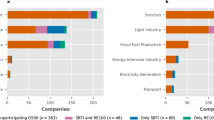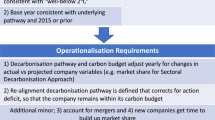Abstract
The integrity of greenhouse gas emissions data is essential to assess progress towards countries’ pledges under the Paris Agreement on climate change. Building credible systems for emissions measurement, reporting and verification is challenging, especially in developing countries. Using a unique dataset from two of China’s pilot emissions trading systems (Beijing and Hubei), we compare firms’ self-reported CO2 emissions with emissions verified by third parties (‘verifiers’). In Beijing, we find that the average discrepancy fell by statistically significant levels (from 17% in 2012 to 4% in 2014 and 2015), while in Hubei it started lower and showed a statistically insignificant decrease (from 6% in 2014 to 5% in 2015). We observe no evidence of deliberate misreporting in these two pilots, and show that improvements in firms’ reporting capacity are associated with discrepancies of decreasing magnitude in Beijing. The results suggest that the administrative and firm capabilities required to support emissions trading systems in developing countries will require substantial time and effort to build.
This is a preview of subscription content, access via your institution
Access options
Access Nature and 54 other Nature Portfolio journals
Get Nature+, our best-value online-access subscription
$29.99 / 30 days
cancel any time
Subscribe to this journal
Receive 12 print issues and online access
$209.00 per year
only $17.42 per issue
Buy this article
- Purchase on Springer Link
- Instant access to full article PDF
Prices may be subject to local taxes which are calculated during checkout



Similar content being viewed by others
Data availability
The original self-reported and verified emissions datasets were developed and are maintained by offices within the Chinese government, and can be accessed only with official permission. We make available all scripts that replicate the results presented in this study at https://github.com/zhangda1021/ChinaMRV. Additional data that support the findings of this study are available from the corresponding authors upon request.
References
Handbook on Measurement, Reporting and Verification for Developing Country Parties (United Nations Framework Convention on Climate Change, 2014).
Duflo, E., Greenstone, M., Pande, R. & Ryan, N. Truth-telling by third-party auditors and the response of polluting firms: experimental evidence from India. Q. J. Econ. 128, 1499–1545 (2013).
Global Corruption Report: Climate Change (ed. Transparency International) (Routledge, London, 2013).
Guan, D., Liu, Z., Lindner, S. & Hubacek, K. The gigatonne gap in China carbon dioxide inventories. Nat. Clim. Change 2, 672–675 (2012).
China Energy Statistical Yearbook 2016 (China Statistics Press, Beijing, 2016).
Recent Statistical Revisions Suggest Higher Historical Coal Consumption in China (EIA, 2015); https://www.eia.gov/todayinenergy/detail.php?id=22952
Ghanem, D. & Zhang, J. `Effortless perfection’: Do Chinese cities manipulate air pollution data?. J. Environ. Econ. Manage. 68, 203–225 (2014).
Zhang, D., Karplus, V. J., Cassisa, C. & Zhang, X. Emissions trading in China: progress and prospects. Energy Policy 75, 9–16 (2014).
Mckenzie, D. Beyond baseline and follow-up: the case for more T in experiments. J. Dev. Econ. 99, 210–221 (2012).
Dasgupta, S., Laplante, S., Mamingi, N. & Wang, H. Inspections, pollution prices, and environmental performance: evidence from China. Ecol. Econ. 36, 487–498 (2001).
Rahman, D. But who will monitor the monitor? Am. Econ. Rev. 102, 2767–2797 (2012).
Turnbull, J. C., Keller, E. D., Morris, M. W. & Wiltshire, R. W. Independent evaluation of point source fossil fuel CO2 emissions to better than 10%. Proc. Natl Acad. Sci. USA 113, 10287–10291 (2016).
Schmalensee, R. & Stavins, R. N. Lessons learned from three decades of experience with cap and trade. Rev. Environ. Econ. Policy 11, 59–79 (2017).
Hsu, A., Cheng, Y., Weinfurter, A., Xu, K. & Yick, C. Track climate pledges of cities and companies. Nature 532, 303–306 (2016).
Gray, W. B. & Shimshack, J. P. The effectiveness of environmental monitoring and enforcement: a review of the empirical evidence. Rev. Environ. Econ. Policy 5, 3–24 (2011).
Abowd, J., Kramarz, F. & Margolis, D. N. High wage workers and high wage firms. Econometrica 67, 251–333 (1999).
Davis, P. Estimating multi-way error components models with unbalanced data structures. J. Econ. 106, 67–95 (2001).
Bertrand, M. & Schoar, A. Managing with style: the effect of managers on firm policies. Q. J. Econ. 118, 1169–1208 (2003).
Card, D., Heining, J. & Kline, P. Workplace heterogeneity and the rise of West German wage inequality. Q. J. Econ. 128, 967–1015 (2013).
Rothstein, J. Teacher quality in educational production: tracking, decay, and student achievement. Q. J. Econ. 125, 175–214 (2010).
Fee, C. E., Hadlock, C. J. & Pierce, J. R. Managers with and without style: evidence using exogenous variation. Rev. Financ. Stud. 26, 567–601 (2013).
Lang, F. P. & Ohr, R. Openness and Development: Yearbook of Economic and Social Relations 1996 (Physica, Heidelberg, 1996).
Johnson, N. L. Systems of frequency curves generated by methods of translation. Biometrika 36, 149–176 (1949).
John, B. B., Lonnie, M. & Robb, A. L. Alternative transformations to handle extreme values of the dependent variable. J. Am. Stat. Assoc. 83, 123–127 (1988).
Acknowledgements
We acknowledge the support of the National Science Foundation of China (project number 71690244) and Ministry of Science and Technology, China (grant number 2017YFA0605304). We further thank the Energy Information Administration of the US Department of Energy for supporting this work under a cooperative agreement (grant number DE-EI0003030). This research received further support from an MIT Energy Initiative Seed Fund Grant and the MIT Joint Program on the Science and Policy of Global Change, which is funded through a consortium of industrial sponsors and federal grants, including the US Department of Energy (grant number DE-FG02-94ER61937). We are grateful to J. Caron (HEC Montreal), J. Jacoby (MIT), S. Li (Cornell University), B. Pizer (Duke University), R. Schmalensee (MIT), R. Stavins (Harvard University), S. Tanaka (Tufts University), D. Victor (UCSD) and X. Zhou (Harvard University) for helpful comments, and to L. Sun (McGill University) for advice on data visualization.
Author information
Authors and Affiliations
Contributions
V.J.K., D.Z. and X.Z. conceived the research. S.Q. and X.Z. provided the data. J.H., V.J.K., D.Z. and Q.Z. performed the analysis. D.Z. and Q.Z. drew the figures. V.J.K., S.Q., D.Z. and X.Z. wrote the paper and contributed to the interpretation of the findings.
Corresponding authors
Ethics declarations
Competing interests
The authors declare no competing interests.
Additional information
Publisher’s note: Springer Nature remains neutral with regard to jurisdictional claims in published maps and institutional affiliations.
Supplementary information
Supplementary Information
Supplementary Figures 1–3, Supplementary Tables 1–9, Supplementary Note 1
Rights and permissions
About this article
Cite this article
Zhang, D., Zhang, Q., Qi, S. et al. Integrity of firms’ emissions reporting in China’s early carbon markets. Nature Clim Change 9, 164–169 (2019). https://doi.org/10.1038/s41558-018-0394-4
Received:
Accepted:
Published:
Issue Date:
DOI: https://doi.org/10.1038/s41558-018-0394-4
This article is cited by
-
Value chain carbon footprints of Chinese listed companies
Nature Communications (2023)
-
Political strategies for climate and environmental solutions
Nature Sustainability (2023)
-
Adapting to climate risks through cross-border investments: industrial vulnerability and smart city resilience
Climatic Change (2022)
-
Designing a statistical procedure for monitoring global carbon dioxide emissions
Climatic Change (2021)
-
Global roll-out of comprehensive policy measures may aid in bridging emissions gap
Nature Communications (2021)



